State Opening of Parliament
This article needs additional citations for verification. (October 2015) |

The State Opening of Parliament is an event which formally marks the beginning of a session of the Parliament of the United Kingdom. It includes a speech from the throne known as the Queen's Speech (or King's Speech).
The event takes place in the House of Lords chamber on the first day of a new session, which is usually in May or June, and traditionally in November, but can occur at any time of year depending on the timing of General Elections and parliamentary session start dates. It takes place in front of both Houses of Parliament. The monarch, wearing the Imperial State Crown, reads a speech that has been prepared by his or her government outlining its plans for that parliamentary year. In 1974, when two general elections were held, there were two State Openings.
Queen Elizabeth II has opened every session of Parliament since her accession, except in 1959 and 1963 when she was pregnant with Prince Andrew and Prince Edward respectively. Those two sessions were opened by Lords Commissioners, headed by the Archbishop of Canterbury (Geoffrey Fisher in 1959 and Michael Ramsey in 1963), empowered by the Queen. The Lord Chancellor (Viscount Kilmuir in 1959 and Lord Dilhorne in 1963) read the Queen's Speech on those occasions.
Significance[]
The State Opening of Parliament is a ceremony filled with historical ritual and symbolic significance for the governance of the United Kingdom. In one place are assembled the members of all three branches of government, of which the Monarch is the authority and nominal head in each part: the Crown-in-Parliament, (the Queen, together with the House of Commons and the House of Lords), constitutes the legislature; the Queen-in-Council, Her Majesty's Ministers (who are members of one or other House, and members of Her Majesty's Privy Council) constitute the executive; the Queen-on-the-Bench, consisting of Her Majesty's Judges, although not members of either House, are summoned to attend and represent the judiciary. Therefore, the State Opening demonstrates the governance of the United Kingdom but also the separation of powers. The importance of international relations is also represented through the presence in the Chamber of the corps diplomatique.
Sequence of events[]
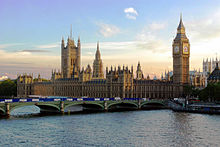
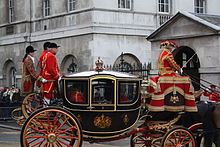

The ceremonial surrounding the opening of parliament can be broken down into several parts:
Searching of the cellars[]
First, the cellars of the Palace of Westminster are searched by the Yeomen of the Guard in order to prevent a modern-day Gunpowder Plot. The Plot of 1605 involved a failed attempt by a group of provincial English Catholics led by Robert Catesby to blow up the Houses of Parliament and kill the Protestant King James I and aristocracy. Since that year, the cellars have been searched, now largely, but not only, for ceremonial purposes. This is supervised by the Lord Great Chamberlain, and the Yeomen are paid for their services with a small glass of port wine.
Assembly of Peers and Commons[]
The peers assemble in the House of Lords wearing their robes. They are joined by senior representatives of the judiciary and members of the diplomatic corps. The Commons assemble in their own chamber, wearing ordinary day dress, and begin the day, as any other, with prayers. The Speaker of the House of Commons makes his usual procession towards the Commons Chamber, accompanied by his Household, the Mace, and a police inspector who makes a traditional cry of "Hats off, strangers." This commands those in Central Lobby to remove their hats in deference to the highest-ranking commoner in the realm.
Delivery of parliamentary hostage[]
Before the monarch departs from Buckingham Palace the Treasurer, Comptroller and Vice-Chamberlain of the Queen's Household (all of whom are government whips) deliver ceremonial white staves to her.[1] The Lord Chamberlain, on behalf of the monarch, keeps the hostage MP (usually the Vice-Chamberlain) "prisoner" for the duration of the state opening, by tradition as a surety for the safe return of the monarch. The hostage MP is well entertained until the successful conclusion of the ceremony, when they are released upon the safe return of the Queen.[1][2][3] The Vice-Chamberlain's imprisonment is now purely ceremonial, though they do remain under guard; originally, it guaranteed the safety of the Sovereign as they entered a possibly hostile Parliament. The tradition stems from the time of Charles I, who had a contentious relationship with Parliament and was eventually beheaded in 1649 during the Civil War between the monarchy and Parliament. A copy of Charles I's death warrant is displayed in the robing room used by the monarch as a ceremonial reminder of what can happen to a monarch who attempts to interfere with Parliament.
Hostage MPs have included:
- 2014: Desmond Swayne[4]
- 2015–16: Kris Hopkins[5]
- 2017: Chris Heaton-Harris[6]
- 2019: Stuart Andrew[7]
Arrival of royal regalia[]
Before the arrival of the sovereign, the Imperial State Crown is carried to the Palace of Westminster in its own State Coach from the Victoria Tower, the Crown is passed by the sovereign's Bargemaster to the Comptroller of the Lord Chamberlain's office, under the watchful eye of the Crown Jeweller. It is then carried, along with the Great Sword of State and the Cap of Maintenance, to be displayed in the Royal Gallery. Also brought in this procession, usually in King Edward VII's Town Coach, are two maces, separate from the three used by parliament, to be displayed by the Sergeants-at-Arms in the Royal Procession.
Arrival of the Sovereign and assembly of Parliament[]

The monarch arrives at the Palace of Westminster from Buckingham Palace in a state coach (since 2014, the Diamond Jubilee State Coach), entering through the Sovereign's Entrance under the Victoria Tower; the monarch is usually accompanied by his or her consort and sometimes by other members of the royal family. Members of the armed forces line the procession route from Buckingham Palace to the Palace of Westminster. As the national anthem is played, the Royal Standard is hoisted to replace the Union Flag upon the Sovereign's entrance and remains flying whilst they are present. Then, after he or she takes on the Parliament Robe of State[8][9] and Imperial State Crown in the Robing Chamber, the monarch proceeds through the Royal Gallery to the House of Lords, usually accompanied by his or her consort and immediately preceded by the Earl Marshal, and by one peer (usually the Leader of the House of Lords) carrying the Cap of Maintenance on a white rod, and another peer (generally a retired senior military officer) carrying the Great Sword of State, all following the Lord Great Chamberlain and his white stick, commonly the practical implement of ceremonial ushers, raised aloft. Once seated on the throne, the monarch, wearing the Imperial State Crown, instructs the House by saying, "My Lords, pray be seated"; her consort takes his seat on the throne to her left and other members of the royal family may be seated elsewhere on the dais (for instance the Prince or Princess of Wales may be seated on a chair of state on a lower portion of the dais to the monarch's right).
Royal summons of the Commons to the Lords' chamber[]
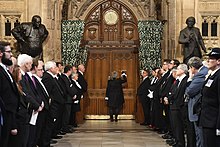
Motioned by the monarch, the Lord Great Chamberlain raises his wand of office to signal to the Gentleman/Lady Usher of the Black Rod (known as Black Rod), who is charged with summoning the House of Commons and has been waiting in the Central Lobby. Black Rod turns and, under the escort of the Door-keeper of the House of Lords and a police inspector, proceeds to the Members' Lobby of the House of Commons, and reaches the doors of the Commons.

In 1642, King Charles I stormed into the House of Commons in an unsuccessful attempt to arrest the Five Members, who included the celebrated English patriot and leading parliamentarian John Hampden.[10][11] Since that time, no British monarch has entered the House of Commons when it is sitting.[12]
On Black Rod's approach, the Doorkeeper of the Commons orders that the doors are slammed shut against them, symbolising the rights of parliament and its independence from the monarch.[12] The Usher of the Black Rod then strikes with the end of their ceremonial staff (the Black Rod) three times on the closed doors of the Commons Chamber, and is then admitted. (There is a mark on the door of the Commons showing the repeated indentations made by Black Rods over the years.) The Chief Door-keeper of the House of Commons introduces Black Rod. At the bar, Black Rod bows to the Speaker before proceeding to the table, bowing again, and announcing the command of the monarch for the attendance of the Commons, in the following words:
Mr [or Madam] Speaker, The Queen commands this honourable House [pauses to bow to both sides of the House] to attend Her Majesty immediately in the House of Peers.
A tradition developed in recent years for this command to be greeted with a defiant topical comment by republican-leaning Labour MP (until 2019) Dennis Skinner, upon which, with some mirth, the House rises to make their way to the Lords' Chamber.[12] This customary intervention was omitted by Mr Skinner in 2015, claiming that he had "bigger fish to fry than uttering something", due to a dispute over seating with the Scottish Nationalists.[13] Skinner resumed the practice in 2016, until he was unseated in 2019.[14]
Procession of the Commons[]
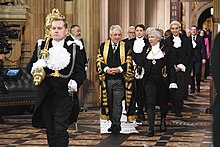
The Speaker proceeds to attend the summons at once. The Serjeant-at-Arms picks up the ceremonial mace and, with the Speaker and Black Rod, leads the Members of the House of Commons as they walk, in pairs, towards the House of Lords. However, this was not done in the 2021 State Opening of Parliament due to social distancing guidelines related to the COVID-19 Pandemic. By custom, the members saunter, with much discussion and joking, rather than formally process. The Prime Minister and the Leader of the Opposition followed by The Deputy Prime Minister, First Secretary of State or another member of the government and the Deputy Leader of the Opposition usually walk side by side, leading the two lines of MPs. The Commons then arrive at the Bar of the House of Lords. The only people required to bow are the House of Commons Speaker, Commons Clerk, senior Lords official Black Rod and the Serjeant-at-Arms. No person who is not a member of the Upper House may pass the Bar unbidden when it is in session; a similar rule applies to the Commons. They remain standing at the Bar during the speech.
Delivery of the speech from the throne[]
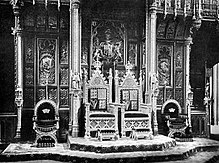
The monarch reads a prepared speech, known as the "Speech from the Throne" or the "Queen's Speech", outlining the Government's agenda for the coming year. The speech is written by the Prime Minister and their cabinet members, and reflects the legislative agenda for which the Government seeks the agreement of both Houses of Parliament. It is traditionally written on goatskin vellum, and presented on bended knee for the monarch to read by the Lord Chancellor, who produces the scroll from a satchel-like bag. Traditionally, rather than turning his back on the Sovereign, which might appear disrespectful, the Lord Chancellor walks backwards down the steps of the throne, continuing to face the monarch. Lord Irvine of Lairg, the Lord Chancellor at the time, sought to break the custom and applied successfully for permission to turn his back on the sovereign and walk down the steps forwards. The next Lord Chancellor, Jack Straw, continued the former tradition but succeeding Lords Chancellor have chosen to walk forwards.
The whole speech is addressed to "My Lords and Members of the House of Commons", with one significant exception that the monarch says specifically, "Members of the House of Commons, estimates for the public services will be laid before you", since the budget is constitutionally reserved to the Commons.
The monarch reads the entire speech in a neutral and formal tone, implying neither approval nor disapproval of the proposals of Her Government: the monarch makes constant reference to "My Government" when reading the text. After listing the main bills to be introduced during the session, the monarch states: "Other measures will be laid before you", thus leaving the government scope to introduce bills not mentioned in the speech. The monarch mentions any state visits that she intends to make and also any planned state visits of foreign heads of state to the United Kingdom during the parliamentary session. The monarch concludes the speech in saying:
"My Lords and Members of the House of Commons, I pray that the blessing of Almighty God may rest upon your counsels".
Traditionally, the members of both houses of Parliament listen to the speech respectfully, neither applauding nor showing dissent towards its contents before it is debated in each house. This silence, however, was broken in 1998, when Queen Elizabeth II announced the government's plan of abolishing the right of hereditary peers to automatically sit in the House of Lords. A few Labour members of the House of Commons cried "yes" and "hear", prompting several of the Lords to shout "no" and "shame". The Queen continued delivering her speech without any pause, ignoring the intervention. The conduct of those who interrupted the speech was strongly criticised at the time.[15][16]
Departure of monarch[]


Following the speech, the monarch and his or her retinue leave the chamber. The monarch bows to both sides of the House of Peers and then leaves the chamber, in the reverse order of the usual procession, before the Commons bow again and return to their Chamber.
Debate on the speech[]
After the departure of the Queen from the palace, each Chamber proceeds to the consideration of an "Address in Reply to Her Majesty's Gracious Speech." But first, each House considers a bill pro forma to symbolise their right to deliberate independently of the monarch. In the House of Lords, the bill is called the Select Vestries Bill, while the Commons equivalent is the Outlawries Bill. The bills are considered for the sake of ceremony only, and do not make any actual legislative progress. For the address in reply, a chosen member moves "That an humble Address be presented to Her Majesty, as follows". The following is the form used in the House of Lords and is nearly identical to that used in the House of Commons:
Most Gracious Sovereign, We, Your Majesty's most dutiful and loyal subjects, the Lords Spiritual and Temporal in Parliament assembled, beg leave to thank Your Majesty for the most gracious Speech which Your Majesty has addressed to both Houses of Parliament.[17]
The first speech of the debate in the Commons is, by tradition, a humorous one given by a member selected in advance. The consideration of the address in reply to the Throne Speech is the occasion for a debate on the Government's agenda. The debate on the Address in Reply is spread over several days. On each day, a different topic, such as foreign affairs or finance, is considered. The debate provides an indication of the views of Parliament regarding the government's agenda.
Following this debate, a vote is taken on the Government Programme. Since the Fixed-term Parliaments Act, a general election is not automatically triggered if this vote is lost.[18] Prior to the act, this would have been treated as a vote of no confidence.
"Dressed down State Opening"[]
On three occasions, in March 1974, 2017 and December 2019, the State Opening has been conducted in a "dressed-down" manner, due to the snap general elections held in those years. This form of ceremony has been marked by several changes. Most noticeably, the Queen attended in day dress, rather than the traditional ceremonial robes of state. The Imperial State Crown is carried in front of the Queen, in the same manner as the Sword of State and Cap of Maintenance. Also, no carriages or coaches are used, and the Queen arrives at Westminster by motorcar. There is no military escort in the streets for this procession. Finally, certain personages, such as Heralds and Officers of Arms, are not in attendance at the ceremony. Other than these changes, the ceremony remains largely the same.
In 2021, the ceremony was also scaled down due to the COVID-19 pandemic. The Queen arrived by car at Westminster, and seating was restricted – 74 were allowed in the Lords Chamber, whilst 34 further MPs and peers were able to participate from the gallery. To prevent the spread of the virus, mask-wearing and testing was enforced, and the Lord Chancellor did not directly pass the speech to the Queen, but placed it on a table next to the throne.[19]
Double and cancelled Openings[]
Throughout the twentieth and twenty-first centuries (including in wartime) the State Opening took place on an annual basis, with the following exceptions:[20]
- There were two State Openings in 1914 (and no State Opening in 1915);
- There were two State Openings in 1921 (and no State Opening in 1923);
- There were two State Openings in 1924 (and no State Opening in 1925);
- There were two State Openings in 1974
- There were two State Openings in 2019 (and no State Opening in 2018)
After 1925, the State Opening invariably took place every year (and twice in 1974) until 2010, since when the event has been cancelled thrice:
- In 2011 the State Opening was cancelled by the Conservative/Lib-Dem coalition, to ease the pressure for the planned introduction of legislation for fixed-term Parliaments;[21]
- In 2018 the State Opening was cancelled, by the Conservative minority government, to lengthen the timeframe for the passing of Brexit-related legislation.[22]
- In 2020 the State Opening did not take place, as Parliament had been in session since the December 2019 State Opening, and possibly because of the COVID-19 pandemic and general lockdown in the country.
Origins[]
The Opening of Parliament[23] began out of practical necessity. By the late 14th century, the manner in which the King gathered his nobles and representatives of the Commons had begun to follow an established pattern. First of all, Peers' names were checked against the list of those who had been summoned, and representatives of the Commons were checked against the sheriffs' election returns. The Peers were robed and sat in the Painted Chamber at Westminster; the Commons were summoned, and stood at the Bar (threshold) of the Chamber. A speech or sermon was then given (usually by the Lord Chancellor) explaining why Parliament had been summoned, after which the Lords and Commons went separately to discuss the business in hand. The monarch normally presided, not only for the Opening but also for the deliberations which followed (unless prevented by illness or other pressing matters).
In the Tudor period, the modern structure of Parliament began to emerge, and the monarch no longer attended during normal proceedings. For this reason, the State Opening took on greater symbolic significance as an occasion for the full constitution of the State (Monarch, Lords and Commons) to be seen. In this period, the parliamentary gathering began to be preceded by an open-air State Procession (which often attracted large numbers of onlookers): the Monarch, together with Household retinue, would proceed in State from whichever royal residence was being used, first to Westminster Abbey for a service (usually a Mass of the Holy Ghost, prior to the Reformation), and thence on foot (accompanied by the Lords Spiritual and Temporal in their robes) to the Palace of Westminster for the Opening itself.
Wriothesley Garter Book, 1523[]

The Wriothesley Garter Book, a 1523 illustration by Sir Thomas Wriothesley, depicts King Henry VIII seated in Parliament in that year. It shows a remarkable visual similarity between State Openings of the 16th and 21st centuries. In both cases, the monarch sits on a throne before the Cloth of Estate, crowned and wearing a crimson robe of state; at his right hand sit Cardinal Thomas Wolsey, Archbishop of York and Lord Chancellor, with arms above under a cardinal's hat, and William Warham, Archbishop of Canterbury, with arms above. Behind stands Cuthbert Tunstall, Bishop of London.[24] The Cap of Maintenance and Sword of State are borne by peers standing before the monarch on the left and right respectively; the Lord Great Chamberlain stands alongside, bearing his white wand of office, near the Garter King of Arms in his tabard displaying the royal arms (Sir Thomas Wriothesley himself, the illustrator).[25] Members of the Royal retinue are arrayed behind the King (top right). In the main body of the Chamber, the Bishops are seated on benches to the King's right wearing their parliamentary robes, with the Mitred Abbots behind them. The Lords Temporal are seated to the King's left and on the cross-bench, the status of peers is indicated by the number of miniver bars (white fur edged with gold oak-leaf lace) on their peerage robes: 4 for a duke, 3½ for a marquess, 3 for an earl, 2½ for a viscount, and 2 for a baron. Thus there are 2 dukes, both wearing ducal coronets, the first holding a Marshal's Baton, thus he is the Duke of Norfolk, Earl Marshal of England. Sir William Weston, Prior of the Hospital of St John of Jerusalem, premier baron in the roll of peers, dressed in black, sits at the end of the cross-bench.[24] The judges (red-robed and coifed) are on the woolsacks in the centre (two Chief Justices, eight judges, and four Serjeants-at-Law[24]), and behind them kneel the clerks (with quills and inkpots). At the bottom of the picture members of the House of Commons can be seen behind the Bar of the House, with Sir Thomas More,[24] Speaker of the House of Commons, in the centre, wearing his black and gold robe of state.
Since that time the ceremonial has evolved, but not dramatically. Mitred Abbots were removed from Parliament at the time of the Reformation. In 1679 neither the procession nor the Abbey service took place, due to fears of a Popish Plot; although the procession was subsequently restored, the service in the Abbey was not. The monarch's role in the proceedings changed over time: early on, the monarch would say some introductory words, before calling upon the Lord Chancellor (or Lord Keeper) to address the assembly. James I, however, was accustomed to speak at greater length himself, and sometimes dispensed with the Chancellor's services as spokesman. This varying pattern continued in subsequent reigns (and during the Commonwealth, when Cromwell gave the speech), but from 1679 onwards it became the norm for the monarch alone to speak. Since then, the monarch (if present) has almost invariably given the speech, with the exception of George I (whose command of English was poor) and Victoria (after the death of Prince Albert). A dramatic change was occasioned by the destruction of the old Palace of Westminster by fire in 1834; however, the new palace was designed with the ceremony of the State Opening very much in mind,[26] and the modern ceremony dates from its opening in 1852.[27] The entire State Opening of Parliament was filmed[28] and televised for the first time in 1958.[29]
In 1998, adjustments were made to the ceremonial inside Parliament to shorten the proceedings. The heralds, instead of processing with the monarch, arrived at Parliament earlier and had a separate procession. The number of court officials in the procession was reduced, including one of the ladies in waiting and the Crown Equerry. Also omitted were the three Heads of the Armed Services, represented instead by the Chief of the Defence Staff. Silver Stick in Waiting (the Commander of the Household Cavalry) no longer processed, although Gold Stick-in-Waiting (the honorary Colonel of the Household Cavalry) retained a place.[30]
Equivalents in other countries[]

Similar ceremonies are held in other Commonwealth realms. The governor-general or, in the case of Australia's states and Canada's provinces, the relevant governor or lieutenant governor, respectively, usually delivers the speech from the throne. On occasion, the monarch may open these parliaments and deliver the speech herself. In both Australia and Canada, the last time this occurred was in 1977.[31][32] In New Zealand, the monarch last opened parliament personally in February 1990.[33]
In India, the President of India opens Parliament with an address similar to the Speech from the Throne. This is also the case in Commonwealth Republics with a non-executive Presidency such as Malta, Mauritius and Singapore.
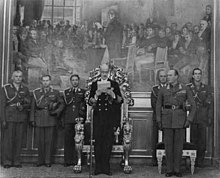
In the Netherlands a similar ceremony is held on the third Tuesday in September, which is called Prinsjesdag in the Netherlands. Article 65 of the constitution states that "A statement of the policy to be pursued by the Government is given by or on behalf of the King before a joint session of the two Houses of the States General that is held every year on the third Tuesday in September or on such earlier date as may be prescribed by Act of Parliament." In Norway, the King is required by Article 74 of the constitution to preside over the opening of the Storting after it had been declared to be legally constituted by the president of the Storting. After he delivers the Speech from the Throne, outlining the government's policies for the coming year, a member of the government reads the Report on the State of the Realm, an account of the government's achievements of the past year.[34]
In Sweden a similar ceremony as the British was held until 1974, when the constitution was changed. The old opening of state was in Sweden called Riksdagens högtidliga öppnande ("The solemn opening of the Riksdag") and was, as the British, full of symbolism. After the abolition of the old state opening, the opening is now held in the Riksdag but in the presence of the monarch and his family. It is still the King who officially opens the parliament. After the opening of parliament the King gives a speech followed by the Prime Minister's declaration of government.
In Israel, a semi-annual ceremony, attended by the President, opens the winter and summer sessions of the Knesset. Though in the past he was a guest sitting in the Knesset's upper deck, the President now attends the ceremony from the speaker's podium and gives his own written address regarding the upcoming session. In the first session of each legislative period of the Knesset, the President has the duty of opening the first session himself and inaugurating the temporary Knesset speaker, and then conducting the inauguration process of all of the Knesset members.
In some countries with presidential or similar systems in which the roles of head of state and head of government are merged, the chief executive's annual speech to the legislative branch is imbued with some of the ceremonial weight of a parliamentary state opening. The most well-known example is the State of the Union Address in the United States. Other examples include the State of the Nation Address in the Philippines, a former American dependency. These speeches differ from a State Opening in at least two respects, however: they do not in fact open the legislative session, and they are delivered by the chief executive on his or her own behalf. In Poland, the President of Poland delivers his speech to the Sejm and the Senate at the First Sitting of these Houses, which is similar to Speech from the Throne. It is rather a custom than a law. Most Presidents of Poland delivered the Speech to the Parliament. The exception was in 2007, when President Lech Kaczyński, instead of addressing the Sejm, watched the First Sitting of the 6th term Sejm from the Presidential box in the Press gallery. The President of Mexico used to be constitutionally obliged to deliver a speech, similar to the American State of the Union, until 2006 when President Vicente Fox was impeded by the opposition parties from entering the Congress building for his sixth and final speech. Since that incident, the Constitution no longer requires the President's presence at the opening of Congress.
References[]
- ^ Jump up to: a b Jennifer Walpole and Richard Kelly (10 October 2008). "The Whip's Office" (PDF). House of Commons Library. Retrieved 11 July 2020.CS1 maint: uses authors parameter (link)
- ^ "Democracy Live, 25 May 2010". BBC. 25 May 2010. Retrieved 7 March 2011.
- ^ "State Opening of Parliament". Directgov. Archived from the original on 29 September 2012. Retrieved 7 March 2011.
- ^ "MP 'held hostage' in Queen's Speech tradition". ITV News. Retrieved 7 June 2014.
- ^ "Traditionally an MP is 'held hostage' at Buckingham Palace til the Queen returns. Today it's Vice Chamberlain @krishopkins2015 #QueensSpeech". House of Commons via Twitter. Retrieved 27 May 2015.
- ^ "The Queen takes Conservative MP hostage at Buckingham Palace – Royal Central". royalcentral.co.uk. Retrieved 7 October 2017.
- ^ "Conservative MP Stuart Andrew taken hostage by The Queen at Buckingham Palace". royalcentral.co.uk. Retrieved 14 October 2019.
- ^ Over this robe is worn the collar and George of the Order of the Garter; the George used is a larger than usual gold representation of St. George slaying a dragon and heavily set with diamonds made for George III.
- ^ The peers also wear their Parliament Robes, also made of crimson velvet and miniver (although the miniver is now often replaced with the much cheaper white rabbit fur). These robes are closed over the right shoulder with bands of gold lace and miniver—four for a duke; three and a half for a marquess; three for an earl or countess; two and a half for a viscount or viscountess and two for a baron or baroness.
- ^ Chisholm, Hugh, ed. (1911). . Encyclopædia Britannica. 4 (11th ed.). Cambridge University Press. pp. 24–25.
- ^ John Joseph Bagley, A. S. Lewis (1977). "Lancashire at War: Cavaliers and Roundheads, 1642-51 : a Series of Talks Broadcast from BBC Radio Blackburn". p. 15. Dalesman
- ^ Jump up to: a b c "Democracy Live: Black Rod". BBC. Retrieved 6 August 2008
- ^ Gani, Aisha (27 May 2015). "Dennis Skinner explains lack of Queen's speech quip: 'I was fighting Scots Nats'". The Guardian. ISSN 0261-3077. Retrieved 6 April 2017.
- ^ https://www.mirror.co.uk/news/uk-news/dennis-skinner-zings-queens-speech-7995683[bare URL]
- ^ "1998: Queen's speech to end peers". BBC News. 31 May 2007.
- ^ "1998: Queen's speech spells end for peers". BBC News. 24 November 1998.
- ^ Companion to the Standing Orders and guide to the Proceedings of the House of Lords , 2.07
- ^ Edgington, Tom (9 October 2019). "Queen's Speech: What is it and why is it important?". BBC News. Retrieved 9 October 2019.
- ^ "Queen's Speech 2021: What can we expect?". BBC News. 10 May 2021. Retrieved 10 May 2021.
- ^ "Queens Speech: Proposers of the Loyal Address in the House of Commons since 1900" (PDF). UK Parliament. Retrieved 30 October 2018.
- ^ "Government accused of 'abuse of power' after cancelling 2011 Queen's speech". The Guardian. Retrieved 30 October 2018.
- ^ "Theresa May cancels 2018 Queen's Speech to give more time to push through Brexit laws". The Independent. Retrieved 30 October 2018.
- ^ Cobb, H.S., 'The Staging of Ceremonies of State in the House of Lords' in The Houses of Parliament: History, Art, Architecture London: Merrell 2000.
- ^ Jump up to: a b c d See catalogue entry, royal collection
- ^ Catalogue entry from 'Royal Treasures, A Golden Jubilee Celebration', London, 2002. per catalogue entry, royal collection [1]
- ^ Cannadine, D., 'The Palace of Westminster as Palace of Varieties' in The Houses of Parliament: History, Art, Architecture London: Merrell 2000
- ^ "The State Opening of Parliament - A Perspective from the Archives" Archived 1 October 2015 at the Wayback Machine, www.parliament.uk. Retrieved 2015-09-21
- ^ State Opening of Parliament (1958) (YouTube). British Pathé. 1958. Retrieved 30 April 2016.
- ^ "State Opening 1958". parliament.uk. UK Parliament. Retrieved 2 November 2017.
- ^ "State Opening loses some pomp". BBC News. 24 November 1998. Retrieved 18 May 2016.
- ^ "Opening of Parliament by the Queen". aph.gov.au. Parliament of Australia. Retrieved 7 October 2017.
- ^ "A visit by the Queen in 1977". cbc.ca. CBC/Radio-Canada. Retrieved 7 October 2017.
- ^ "Display of royal memorabilia". New Zealand Parliament. 29 April 2011. Retrieved 12 November 2018.
During her first eagerly awaited tour over the summer of 1953-4 Parliament was summoned for a special short session in January to allow her to open Parliament and deliver the Speech from the Throne. She again opened a special session of Parliament in February 1963. She also opened Parliament in March 1970 and February 1974. In February 1977 she opened another special session at the same time as formally opening the Beehive (the Executive Wing). More recently she has opened Parliament in February 1986 and February 1990.
- ^ "Opening of the Storting". royalcourt.no. Royal House of Norway. Retrieved 7 October 2017.
External links[]
| Wikimedia Commons has media related to State Opening of Parliament. |
- Videos of every State Opening since 1988 at C-SPAN
- House of Lords FAQ: State Opening at UK Parliament website
- Parliamentary occasions: State Opening at UK Parliament website
- Cost of the 2006 State Opening at Hansard
- Photos of the 2015 ceremony at Flickr
- Newsreel of the 1960 ceremony at YouTube
- Speeches by heads of state
- Parliament of the United Kingdom
- Opening ceremonies
- Ceremonies in the United Kingdom

